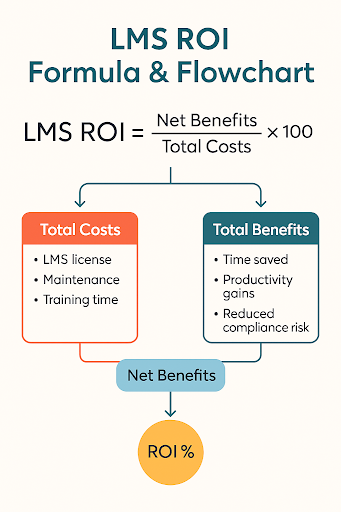- What is LMS ROI?
- Essential Benefits That Drive LMS ROI
- Key Metrics to Measure Learning Management System ROI
- How to Calculate LMS ROI
- Common Mistakes That Lower LMS Return on Investment
- Tips to Improve LMS ROI Without Increasing Cost
- Tools to Help You Evaluate LMS ROI Effectively
- How CSSChopper Enhances LMS ROI Through Custom eLearning Solutions
Return on investment (ROI) is a straightforward way to determine if your money is generating a return. Whether it’s a marketing campaign or a new tech tool, ROI tells you if the return is worth the investment. The same logic applies to your learning management system (LMS).
Tracking LMS ROI helps justify the platform’s cost to leadership. You can show exactly how much value your training programs bring for every dollar invested. It also helps shape smarter decisions for your learning strategy. You’re not just offering courses, you’re investing in business outcomes.
But measuring learning management system ROI isn’t always black and white. Some benefits are harder to quantify. And hidden costs can quietly lower the ROI on LMS if you don’t catch them. That’s why it’s important to dig a little deeper.
In this guide, we’ll walk you through how to measure LMS ROI the right way, its benefits, challenges, key metrics, and offer practical ways to improve it if your numbers fall short.
What is LMS ROI?
LMS ROI stands for Learning Management System Return on Investment. It compares the value gained from using your LMS to the cost of implementing, maintaining, and running it.
“In simpler terms: are you getting real results from your training platform?”
Whether you’re using it for onboarding, compliance, upskilling, or employee engagement, the value of an LMS should pay off in measurable ways. Unfortunately, many businesses don’t track eLearning ROI because they aren’t sure how to measure impact, especially when they’re not directly selling a product or service through it.
Yet, ignoring ROI LMS can be costly in terms of missed opportunities, inefficient learning, and wasted resources.
Essential Benefits That Drive LMS ROI
LMS platforms impact multiple areas, including employee performance, training efficiency, and compliance tracking. However, many organizations miss out on fully quantifying these returns because they jump straight into metrics without defining what success looks like. Before you start measuring, identifying the benefits early makes your LMS ROI calculation more complete and accurate. Let’s understand the benefits of LMS ROI:
- Reduced employee onboarding and training time
- Increased workforce productivity
- Lower compliance training costs
- Fewer mistakes due to better knowledge retention
- Improved employee retention and satisfaction
- Fewer face-to-face training sessions
- Less manager time spent training or supervising
These are your ROI drivers, which encompass both tangible and intangible benefits that accumulate over time. To truly understand the value your Learning Management System brings, it’s essential to look beyond just the upfront costs.
Key Metrics to Measure Learning Management System ROI
When you’re tracking training ROI metrics, avoid vanity stats like number of logins or time spent online. Instead, focus on data that correlates with performance or cost-saving outcomes. Let’s dive deep to find the LMS metrics that matter for ROI.
1. Training Completion Rate
This metric measures the percentage of enrolled users who complete a course. High completion rates often indicate a good user experience and engaging content, both of which are essential for an effective enterprise learning management system.
2. Time-to-Competency
Tracks how long it takes employees to become proficient in a role after training. Shorter time equals faster productivity, which leads to higher ROI of your LMS.
3. Employee Performance Improvements
Use pre- and post-training assessments, manager feedback, or KPIs to quantify improvements linked to employee training ROI.
4. Cost Savings on Instructor-Led Training
Compare your old classroom or webinar-based training costs to your current LMS costs. It includes travel, logistics, printed materials, and instructor fees.
5. Compliance Rates and Audit Passes
This metric is essential if your learning management system software or facility management software supports regulatory training, tracks compliance completion, and its impact on audits or fines.
6. Engagement Metrics
High engagement correlates with knowledge retention. This LMS performance metrics look at logins, course ratings, feedback submissions, and certifications.
How to Calculate LMS ROI
Calculating LMS ROI can feel tricky at first. But don’t worry, we’ll break it down step by step so you can confidently measure the real value it brings.
1. LMS ROI Formula
Let’s start with the core formula. You can measure a learning content management system using the following formula.

(Where, Net Benefits = Total Benefits – Total Costs)
Begin by adding up your total investment. This includes:
- Direct costs
- Subscription fees
- Implementation charges
- Licensing fees for content
Don’t forget indirect expenses, too, such as the time and resources spent training your staff to use the learning management software system effectively.
Once you’ve tallied your costs, move on to net benefits. This covers every measurable gain you’ve seen since adopting the LMS. That might include reduced training time, improved employee performance, better compliance, or fewer errors.
These benefits help paint the full picture of how well your LMS supports your goals and whether it’s delivering a return worth your investment. Let’s see how the LMS ROI calculator functions with an example:
Example: Calculating LMS ROI for small businesses
Let’s say a small business invests $18,000 in its LMS. This includes $4,000 for setup, $8,000 for integration and customization, $3,000 for employee training, and $3,000 for the annual license. The benefits add up to $14,000 in productivity gains, $6,000 in reduced onboarding time, and $3,000 in compliance improvements.
| LMS ROI Calculation With an Example | |
| Total Costs | $18,000 |
| Total Benefits | $23,000 |
| Net Benefits | $5,000 |

So, the LMS ROI will be 27.7%.
As a decision-maker, you also need to take into account significant aspects such as—
-
Training Time Reduction
Time savings are one of the biggest benefits of using the best learning management system. Virtual learning cuts down the time spent organizing in-person sessions, booking rooms, and waiting for everyone to attend together.
-
Revenue Growth
When it comes to a revenue increase, think about the costs you’ve eliminated. No more travel, expensive venue rentals, or stacks of printed materials. That’s money saved and without sacrificing training quality.
-
Productivity Gains
Productivity growth is another major benefit. With quick access to training materials, employees spend less time hunting for information. A robust LMS and operation management software with a search function provides users with answers quickly. That means fewer interruptions and less time spent waiting for colleagues.
As a result, your team gets more done in less time. Over the long run, these gains make a measurable difference in your company’s performance and bottom line.
-
Data-Driven Decisions
Improved decision-making starts with data. A reliable software with built-in LMS analytics and reporting tools that show whether your training is hitting the mark. They help you make smarter choices based on actual learner behavior, which leads to better outcomes and long-term cost savings.
-
Workflow Optimization
As for process improvement, your free learning management system should be doing the heavy lifting. It should automate tasks like onboarding and compliance training. This saves time, reduces errors, and creates a smoother, more consistent experience for every employee across your organization.
2. Evaluate Hidden Internal Gains
The net benefits mentioned earlier are easy to track, but they’re only part of the story. When calculating LMS ROI, it’s just as important to consider the intangible gains. These are harder to measure, but they still carry weight.
-
Higher Employee Retention
Take employee satisfaction and retention, for example. Holding onto your team through consistent learning can increase training ROI, often equivalent to six to nine months’ worth of salary per employee in recruiting and onboarding costs.
-
Lower Customer Churn
Then there’s customer churn. Well-trained employees tend to deliver better service. When your team knows the product inside and out, they’re more confident in handling tough questions. That kind of expertise creates better experiences for your customers.
-
Better Customer Experience
When your customer service representatives understand how to utilize an LMS, they become proficient in handling various scenarios throughout the entire buyer journey. That confidence shows in real conversations. Happier customers tend to stick around and spend more.
-
Stronger Learning Mindset
Your learning content management system software keeps all training content in one place, making it easy for employees to find what they need. When learning feels accessible, people are more likely to engage. Over time, this builds a continuous learning environment.
-
Proactive Risk Reduction
Topics like cybersecurity, workplace safety, and fraud should never be one-and-done lessons. A web development company helps in increasing LMS ROI by delivering regular, up-to-date training. That helps reduce costly mistakes, improve compliance, and protect your business from avoidable issues.
3. Account for Opportunity Costs
Opportunity cost helps you understand the financial impact of not fully using your LMS. It shows what you’re missing out on by sticking with inefficient processes.
Take a large business using an extended enterprise LMS. It doesn’t automate workflows or train customers on the same platform. As a result, it wastes time on repetitive tasks and pays for two systems instead of one. That’s time lost and money drained.
If that shortfall flips your LMS ROI from positive to negative, it’s a red flag. This helps you refocus your LMS strategy and invest where it truly counts. Sometimes, what you’re not doing can be just as costly as what you’re doing.
Also Read | A comprehensive guide on Warehouse Management System

Common Mistakes That Lower LMS Return on Investment
Let’s be honest, even the most advanced platform won’t deliver ROI if misused. Watch out for these traps:
1. Not aligning training goals with business goals
If the learning doesn’t support performance or growth, it won’t drive results.
2. Overloaded or outdated content
Too much content with little relevance confuses learners and dilutes value.
3. Underutilizing features
Many platforms have built-in tools (like automation, reporting, and gamification) that go unused.
4. No post-training measurement
Without follow-up, you’ll never know what’s working and what isn’t.
5. One-size-fits-all training
Generic modules lead to low engagement. Personalized paths lead to better LMS value.
Tips to Improve LMS ROI Without Increasing Cost
Once you’ve calculated your LMS ROI, the results might fall short of your expectations. The good news? You don’t need to start over. A few strategic adjustments can help you boost returns and maximize LMS ROI.
| Cost-Effective LMS ROI Boosters | ||
| Strategy | Description | Estimated Cost Impact |
| Repurpose existing content | Use past videos, slides, and manuals | No new cost |
| Enable peer learning | Let employees share knowledge internally | Zero or minimal |
| Automate admin tasks | Use built-in workflows for enrollment and reminders | Saves time and manual effort |
| Improve engagement | Add gamification and microlearning | Uses existing LMS tools |
Tools to Help You Evaluate LMS ROI Effectively
To make smarter learning decisions, you need the right tools. From built-in LMS reports to external ROI calculators, these solutions help track performance, identify hidden costs, and demonstrate the impact of training.
| Best Tools to Track ROI | |
| Tool | Purpose |
| Google Sheets | Use ROI templates to manually calculate training costs vs. benefits. |
| Kirkpatrick Model | A 4-level framework to evaluate reaction, learning, behavior, and results. |
| LMS Reporting Modules | Built-in dashboards that offer visual insights into learner progress. |
| Surveys & Feedback Tools | Gather input on what learners found useful, confusing, or missing. |
| Integration Platforms (Zapier, Make) | Automate LMS data reporting or sync with HR/CRM systems. |
How CSSChopper Enhances LMS ROI Through Custom eLearning Solutions
Measuring LMS ROI is key to showing its true value. It helps you make smarter decisions about your training budget. When you know how to calculate LMS ROI and what affects it, you can fine-tune your strategy. This way, your LMS Software development for startups delivers stronger results and ensures every dollar spent drives meaningful business impact.
At CSSChopper, we increase LMS ROI by delivering custom eLearning solutions that truly fit your business needs. We don’t believe in generic training. Instead, we design engaging, user-focused modules that improve retention and boost learner outcomes.
Our team integrates smart analytics, streamlines content delivery, and ensures your platform performs at its best. This way, you get higher LMS ROI benchmarks without increasing your costs.
Categories
Recent Posts
Popular Posts
- How to Choose a Reliable Offshore Development Partner?
- Transforming Web Development with HTMX’s Declarative Approach for Dynamic UIs
- Why Your Conversion Funnel Needs a Composable Commerce Solution?
- How to Outsource Web Development in 2025: Complete Guide
- What are the Top Web Development Trends for 2025?




